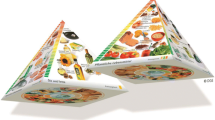Abstract
An evaluation was made of theassociations between self-reported healthconscious consumerism, body-mass index (BMI),and consumer beliefs, attitudes, intentions,and behaviors regarding sustainably producedfoods. Self-administered surveys were completedby adult consumers (n = 550) in threemetropolitan Minnesota grocery stores. Selecteddemographic and psychographic differencesbetween health conscious consumers andnon-health conscious consumers were evaluated.Compared to non-health conscious consumers,health conscious consumers were more likely tobe female, older, more educated, higher incomeearners, more active, healthier, and possess ahealthier body mass index. They also held moresupportive beliefs, attitudes, and intentionswith regard to sustainably produced foods. Inconclusion, some consumers are interested insupporting sustainable production practices andtheir support may be linked to improvedpersonal, environmental, and communityhealth.
Similar content being viewed by others
References
American Society of Agronomy (1989). “Decisions reached on sustainable agriculture.” Agronomy News, January (p. 15).
Ary, D., L. C. Jacobs, and A. Razavieh (1990). Introduction to Research Education, 4th edition (p. 153). Fort Worth, Texas: Holt, Rinehart, and Winston.
Brooker, J., D. B. Eastwood, and R. H. Orr (1987). “Consumers' perceptions of locally grown produce at retail outlets.” Journal of Food Distribution Research 18: 99–107.
Brooker, J., D. B. Eastwood, C. L. Stout, and R. H. Orr (1988). “Branding locally grown produce in supermarkets.” Journal of Food Distribution Research Feb: 51–60.
Byrne, P. J., U. C. Toensmeyer, C. L. German, and H. R. Muller (1992). “Evaluation of consumer attitudes towards organic produce in Delaware and the Delmarva region.” Journal of Food Distribution Research 23: 29–44.
Clancy, K. (1999). “Reclaiming the social and environmental roots of nutrition education.” Journal of Nutrition Education 31: 190–193.
Cronbach, L. J. (1951). “Coefficient alpha and the internal structure of tests.” Psychometrika 16: 297–344.
Feenstra, G. (1997). “Local food systems and sustainable communities.” American Journal of Alternative Agriculture 12: 28–36.
FMI/Princeton Survey Research Associates (1997). Shopping for health 1997: Balancing convenience, nutrition, and taste. Emmaus, Pennsylvania: Food Marketing Institute/Prevention Magazine.
French, S. A., M. Story, and R. W. Jeffery (2001). “Environmental influences on eating and physical activity.” Annual Review of Public Health 22: 309–335.
Furst, T., M. Connors, C. A. Bisogni, J. Sobal, and L. W. Falk (1996). “Food choice: a conceptual model of the process.” Appetite 26: 247–266.
Goldman, B. J. and K. L. Clancy (1991). “A survey of organic produce purchases and related attitudes of food cooperative shoppers.” American Journal of Alternative Agriculture 6: 89–96.
Gussow, J. D. (1999). “Dietary guidelines for sustainability: twelve years later.” Journal of Nutrition Education 31: 194–200.
Gussow, J. D. and K. L. Clancy (1986). “Dietary guidelines for sustainability.” Journal of Nutrition Education 18: 1–5.
Hartman Group (1996). Food and the Environment: A Consumer's Perspective, Phase I. Bellevue, Washington: Hartman Group.
Hartman Group (1997). Food and the Environment: A Consumer's Perspective, Phase II. Bellevue, Washington: Hartman Group.
Hill, J. O. and J. C. Peters (1998). “Environmental contributions to the obesity epidemic.” Science 280: 1371–1374.
Hillers, V. (1991). “Changing agriculture: roles for food and nutrition educators.” Journal of Nutrition Education 23: 36–38.
Jolly, D. A. (1991). “Differences between buyers and nonbuyers of organic produce and willingness to pay organic price premiums.” Journal of Agribusiness 9: 97–111.
Kuczmarski, M. F., R. J. Kuczmarski, and M. Najjar (2001). “Effects of age on validity of self-reported height, weight, and body mass index: findings from the third National Health and Nutrition Examination Survey, 1988-1994.” Journal of the American Dietetic Association 1: 28–34.
Landis, J. R. and G. G. Koch (1977). “The measurement of observer agreement for categorical data.” Biometrics 33: 159–174.
Lee, R. D. and D. C. Nieman (1996). “Anthropometry.” In Nutritional Assessment. St. Louis, Missour: Mosby-Year Book.
Lockeretz, W. (1986). “Urban consumers' attitudes towards locally grown produce.” American Journal of Alternative Agriculture 1: 83–88.
Markle, S. (1997). “Consumer demand growing for organic, local foods.” Community Nutrition Institute Newsletter. 27: 4–6.
Midwest Food Alliance (2000). “Midwest Food Alliance guiding principles.” In MWFA Program Kit. St. Paul, Minnesota: MWFA.
Misra, S., C. L. Huang, and S. L. Ott (1991). “Georgia consumers' preference for organically grown fresh produce.” Journal of Agribusiness Fall: 53–65.
Nestle, M. and M. F. Jacobson (2000). “Halting the obesity epidemic: a public health policy approach.” Public Health Reports 115: 12–24.
Nestle, M., R. Wing, and L. Birch, et al. (1998). “Behavioral and social influences on food choice.” Nutrition Reviews 56: S50–S74.
Peters, J. (1997). “Community food systems: working toward a sustainable future.” Journal of the American Dietetic Association 97: 955–956.
Ross, N. J., M. D. Anderson, J. P. Goldberg, R. Houser, and B. L. Rogers (1999). “Trying and buying locally grown produce at the workplace: results of a marketing intervention.” American Journal of Alternative Agriculture 14: 171–179.
Ross, N. J., M. D. Anderson, J. P. Goldberg, and B. L. Rogers (2000). “Increasing purchases of locally grown produce through worksite sales: an ecological model.” Journal of Nutrition Education 32: 304–313.
Tarrance Group (2001). “Voters support farm and ranch conservation efforts.” Retrieved from http://www.farmland.org on August 8, 2001.
Thompson, G. D. and J. Kidwell (1998). “Explaining the choice of organic produce: cosmetic defects, prices, and consumer preferences.” American Journal of Agricultural Economics 80: 277–287.
United States Department of Agriculture (1997). Exploring sustainability in agriculture. Washington, DC: Sustainable Agricultural Research and Education.
Wilkins, J. L. (1996). “Seasonality, food origin, and food preference: A comparison between food cooperative members and nonmembers.” Journal of Nutrition Education 28: 329–337.
Wilkins, J. L. and V. N. Hillers (1994). “Influences of pesticide residue and environmental concerns on organic food preference among food cooperative members and non-members in Washington state.” Journal of Nutrition Education 26: 26–33.
Wilkins, J. L., E. Bowdish, and J. Sobal (2000). “University student perceptions of seasonal and local foods.” Journal of Nutrition Education 32: 261–268.
Author information
Authors and Affiliations
Corresponding author
Rights and permissions
About this article
Cite this article
Robinson, R., Smith, C. Associations between self-reported health conscious consumerism, body-mass index, and attitudes about sustainably produced foods. Agriculture and Human Values 20, 177–187 (2003). https://doi.org/10.1023/A:1024017610510
Issue Date:
DOI: https://doi.org/10.1023/A:1024017610510




